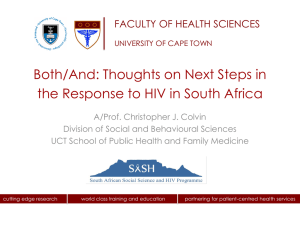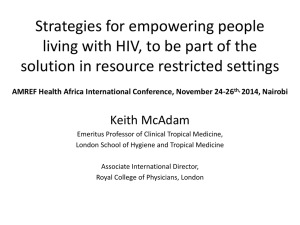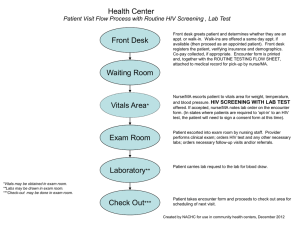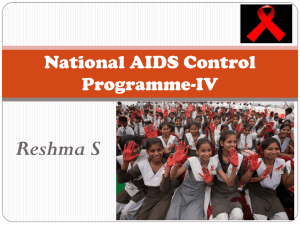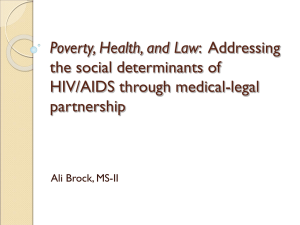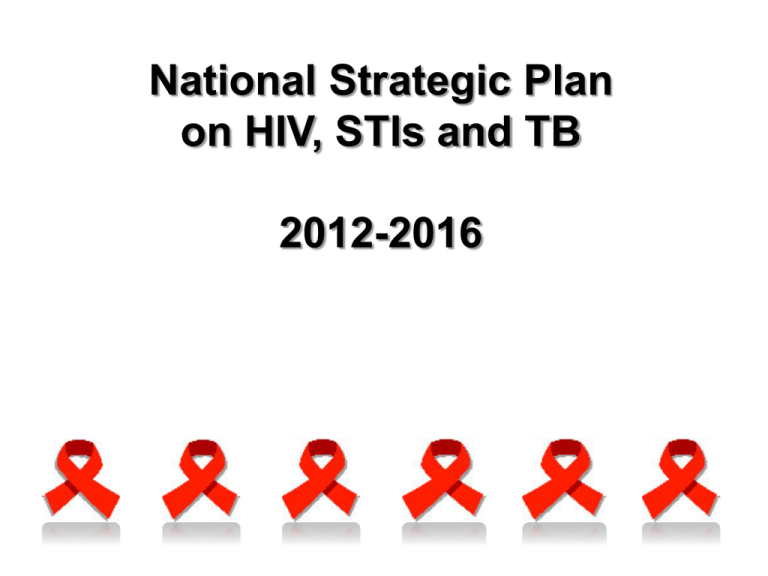
National Strategic Plan
on HIV, STIs and TB
2012-2016
Introduction
The NSP is the strategic guide for HIV, STI and TB initiatives for the
next five years. The plan is results-based and focused on the
drivers of the epidemics, building on the achievements in previous
NSPs to achieve its goals.
The NSP aims to inform national, provincial, district and communitylevel stakeholders on strategic directions to be taken into
consideration when developing strategies and implementation plans.
The NSP is firmly located within the Constitutional framework of
South Africa and strives towards its ideals of human dignity, nonracialism, non-sexism and the rule of law.
The NSP is aligned with international and regional obligations,
commitments and targets related to HIV, STIs and TB.
continue
The HIV, STI and TB National Strategic Plan (NSP) 2012-2016 is
the culmination of extensive review of achievements against the
goals and objectives set out in the NSP 2007-2011 using reports,
documentation, consultation and deliberation over several months
with a wide range of stakeholders. These processes were key to
determine the strategic priorities in dealing with the dual epidemics
of HIV and TB in South Africa.
Every government department, sector and provincial authority will
need to develop implementation plans by March 2012 in line with
the NSP.
Vision and Goals
• The NSP 2012-2016 is driven by a long-term vision for the country
with respect to the HIV and TB epidemics. It has adopted, as a
twenty-year vision, the Three Zeros that have been advocated for by
UNAIDS. These are:
• Zero new HIV, STI and TB infections
• Zero deaths associated with HIV and TB
• Zero discrimination
Vision and Goals (continue)
In line with this twenty-year vision, the NSP 2012-2016 has the
following broad goals. To:
Reduce new HIV infections by at least 50% using combination
prevention approaches;
Initiate at least 80% of eligible patients on antiretroviral treatment
(ART), with 70% of those alive and on treatment five years after
initiation;
Reduce the number of new TB infections as well as deaths from
TB by 50%;
Ensure an enabling and accessible legal framework that protects
and promotes human rights in order to support implementation of
the NSP;
Reduce self-reported stigma related to HIV and TB by at least
50%.
NSP Implementation
The NSP was launched on World AIDS Day 1 December 2011.
Costed sector and provincial implementation plans will be finalised
and launched on World TB Day, 24 March 2012 with implementation
commencing on 1 April 2012.
All implementation plans must be multisectoral in their orientation
and clearly demonstrate accountability and responsibility for all
interventions across all stakeholders (for example, the role of civil
society stakeholders in the implementation of interventions in a
specific province), and driven by the provincial and district AIDS
councils.
A team, appointed by the Deputy President, is currently reviewing
the structure and function of SANAC. This team is reviewing
aspects of governance, technical support and the functioning of the
secretariat. The restructured SANAC and secretariat will be
responsible for all aspects of the implementation of this NSP.
NSP Strategic Objectives
For the next five years, the following four strategic objectives will form the
basis of the collective HIV, STI and TB response that will in turn provide the
impetus towards achieving the twenty-year Three Zeros vision:
Focus on social and Structural Approaches to HIV and TB Prevention, Care
and Impact – the primary objective being to address societal norms and
behaviours that fuel the twin epidemics of HIV and TB, as well as
structural interventions to reduce vulnerability to and to mitigate the
impacts of HIV and TB;
Prevention of new HIV, STI and TB Infections – the primary objective being
to ensure a multi-pronged approach to HIV, STI and TB prevention that
includes all biomedical, behavioural, social and structural approaches
in order to reduce new HIV, STI and TB infections;
Sustain Health and Wellness – the primary objective being to ensure access
to quality treatment, care and support services for those with HIV and/or
TB and to develop programmes to focus on wellness; and
Protection of Human Rights and Promotion of Access to Justice – the
primary objective being to address issues of stigma, discrimination,
human rights violations, and gender inequality.
Epidemiology of HIV, STIs and TB
South Africa has a generalised HIV epidemic, which has stabilised over
the last four years at a national antenatal prevalence of around 30%.
South Africa currently ranks the third highest in the world in terms of TB
burden, with an incidence that has increased by 400% in the past 15
years.
It is estimated that 80% of the South African population is infected with
the TB bacillus, however not all individuals infected with TB will develop
active TB (also called TB disease).
Certain populations are at higher risk of TB infection, including:
healthcare workers, miners, prisoners, prison officers and household
contacts of confirmed TB patients.
In addition, certain groups are particularly vulnerable to progressing
from TB infection to TB disease. These include infants, young children,
people living with HIV, diabetics, smokers, alcohol and substance users
and people who are malnourished. These groups are considered ‘key
populations’ for TB.
The HIV Epidemic
An understanding of the epidemics and the key drivers thereof are
fundamental in guiding the NSP. A review of the evidence shows that
the HIV prevalence in pregnant women attending public sector clinics is
stabilizing at a very high level of around 30%.
However, there is marked heterogeneity in HIV prevalence by key
epidemiological variables such as age, race, gender, geographical
location and social economic status reflecting differentials in exposure to
risk of infection.
South Africa has a generalised HIV epidemic driven largely by sexual
transmission. Using the Spectrum model, in 2009 the HIV prevalence in
the adult population (aged 15-49) was estimated at 17.8%. An estimated
5.63 million adults and children were living with HIV. Of these, 5.3
million were adults aged 15 years and older, 3.3 million were females
and 334,000 were children.
The TB Epidemic
The World Health Organization (WHO) estimates shows that South
Africa currently ranks the third highest in the world in terms of TB
burden, behind India and China with an incidence that has increased by
400% in the past 15 years, reaching 970 new infections per 100,000
population in 2009. This increase in incidence is compounded by
multidrug-resistant tuberculosis (MDR-TB), with almost 7,386 confirmed
MDR-TB cases in 2010 and 741 confirmed cases of extensively drugresistant TB (XDR-TB) during the same period. The HIV epidemic is
currently driving the TB epidemic with more than 70% of TB patients also
living with HIV.
Approximately 1% of the South African population develop TB disease
every year. Case detection for all forms of TB has steadily increased
from 279,260 in 2004 to 401,608 in 2010. 2011.
The TB epidemic is further compounded by multidrug-resistant
tuberculosis (MDR-TB), with almost 7,386 laboratory confirmed MDR-TB
cases and 741 confirmed cases of extensively drug-resistant TB (XDRTB) in 2010.
Key Populations for HIV & TB Response
Young women between the ages of 15 and 24 years are four times more
likely to have HIV than males of the same age.
People living or working along national roads and highways;
People living in informal settlements in urban areas
Young people who are not attending school.
People with the lowest socio-economic status are associated with HIV
infection.
Uncircumcised men.
Persons with disabilities have higher rates of HIV.
Men who have sex with men (MSM)
Sex workers and their male clients
People who use illegal substances
Alcohol abuse
Transgender persons
Orphans and other vulnerable children and youth
• Up to 80% of the South African population is infected with the TB
bacillus, but certain populations are at higher risk of TB infection.
These high-risk groups include: healthcare workers, mine workers,
prisoners, prison officers and household contacts of confirmed TB
cases. In addition, certain groups are particularly vulnerable to
progressing from TB infection to TB disease. These include infants,
young children, people living with HIV, diabetics, smokers, people
with silicosis, alcohol and substance users and people who are
malnourished, or have silicosis. However, little research has been
done to quantify the contribution of the various risk factors to the TB
burden in South Africa in the same way as the KYE studies have
done for HIV. This will be addressed in this NSP (KYE for TB).
• In addition, and similar to HIV, certain groups are considered key
populations for TB. Taking risk of TB infection, risk of progression
from infection to TB disease and poor access to services into
account, the following groups should be prioritised for TB services:
Household contacts of confirmed TB cases, including infants and
young children;
Healthcare workers, mine workers, correctional services staff
and inmates;
Children and adults living with HIV;
Diabetics and people who are malnourished;
Smokers, drug users and alcohol abusers;
Mobile, migrant and refugee populations; and
People living and working in poorly ventilated and overcrowded
environments, including those that live in informal settlements.
Strategic Enabler – Effective
Communication
Strategic enablers are factors that are critical to the successful
implementation of the NSP. They are systems or structures at all
levels, which, if absent or inadequately addressed, will negatively
impact on the achievement of the goals and objectives of the NSP.
Four strategic enablers have been identified as key to the success
of the NSP. These are:
Effective governance and institutional arrangements;
Effective communication;
Regular monitoring and evaluation; and
Relevant and focused research.
Communication
The first type of communication that needs to be strengthened is
between the national and provincial efforts and between sectors to
ensure that all efforts are coordinated and focus on achieving the
goals of the NSP.
The second type of communication critical for implementation is that
of communicating with and through the media about the NSP and its
goals, principles, interventions and successes and challenges.
Thirdly, social and behaviour change communication is critical to
changing risk behaviours and the social conditions that drive the HIV,
STI and TB epidemics. This encompasses the individual, community
and socio-political levels and includes advocacy, media,
social/community mobilisation and campaigns.
Behavioural and Social Determinants
Sexual Debut – Tailored prevention interventions for the youth to
facilitate delay of sexual debut and sustain protective behaviours
Multiple sexual partners – Multi-level interventions focusing on sexual,
social and cultural norms and values
Condom use – Increase consistent use, especially among key
populations, including those involved in sex work
Age-disparate sexual (intergenerational) relationships – Target
prevention strategies at those men and women who have partners
much younger/older than themselves given they are more likely to be
HIV-positive than people who reported partners of similar age only
Alcohol and substance abuse – Interventions to decrease alcohol
abuse and other substance abuse (including illegal substances)
Prevention knowledge and risk perception – Prevention strategies for
people who continuously expose themselves to the risk of HIV
infection because of incorrect perceptions of personal risk
Biological Determinants
Mother to Child Transmission – Strengthen the implementing the
four prongs of the PMTCT programme
Male Medical Circumcision – Continue with aggressive rollout of a
national medical male circumcision programme
Other Sexually Transmitted Infections – Prevention and early
treatment of STIs
Structural Determinants
Mobility and Migration – The risk of HIV infection is higher among
individuals who either have personal migration experience or have
sexual partners who are migrants and therefore appropriately
targeted interventions are required
Gender Roles and Norms – Address the position of women in
society, particularly their economic standing
Sexual Abuse and Intimate Partner Violence – Interventions on
gender-based violence and intimate partner violence
NSP STRATEGIC OBJECTIVES
Strategic Objective 1 (SO 1):
Address Social and Structural
Approaches to HIV and TB Prevention, Care and Impact
Strategic Objective 1 (SO 1) is focused specifically on structural
factors that are amenable to change. Some of the structural
approaches seek to address deeply entrenched and long-established
cultural, socio-economic and behavioural factors such as economic
inequality, gender inequality, marginalisation and lack of access to
basic services that are difficult to resolve in the short-term.
Eight sub-objectives, and lead agencies for their implementation, have
been identified.
These are:
Sub-Objective 1.1: Mainstream HIV and TB and its gender and
rights-based dimensions into the core mandates of all government
departments;
Government in its entirety has the responsibility for defining the
development agenda of the country.
Given the profound impact of HIV and TB and the huge burden
of disease attributable to these epidemics, every government
department (at national, provincial and municipal levels) has a
critical role to play in addressing the social, economic and
structural factors driving these diseases.
Sub-Objective 1.2: Address social, economic and behavioural
drivers of HIV, STIs and TB. This includes addressing challenges
posed by:
Socialisation practises
Informal Settlements
Rural and Hard to Reach Areas (including farms)
Migration and Mobility
Alcohol and Substance Use
Sub-Objective 1.3: Implement interventions to address gender
norms and gender-based violence as drivers of HIV and STIs
The achievement of gender equality remains one of the critical
components of the transformation agenda.
Violence against women with sexual assault and intimate partner
violence contributing are increasing risks for HIV infection.
A concerted effort is required to deal with violence broadly to
address HIV transmission.
The department in the social and security clusters of government
at national and provincial levels must develop a comprehensive
approach to reducing gender-violence in society.
Sub-Objective 1.4: Mitigate the impact of HIV, STIs and TB on
orphans, vulnerable children and youth;
The numbers of orphans and children made vulnerable by HIV
has increased over the years.
The Department of Social Development has been leading
activities to protect the rights of orphans, vulnerable children and
youth and to reduce their vulnerability and impact of HIV and TB.
Mental health services must also provide to support orphans and
vulnerable children.
Sub-Objective 1.5: Reduce the vulnerability of young people to
HIV infection by retaining them in schools as well as increasing
access to post-school education and work opportunities;
Ensuring school completion is a critical intervention to ensure
that learners acquire knowledge and skills to improve
employment opportunities, and life skills to negotiate a safe
transition into adulthood, including with respect to HIV.
Educating parents and caregivers to encourage intergenerational conversations with young people on sex and
sexuality will be prioritised.
School-going children and young people are less likely to
become HIV-positive than those who do not attend school, even
if HIV is not included in the curriculum
Sub-Objective 1.6: Reduce HIV and TB related stigma and
discrimination
A clear programme of action that covers innovative and
established methods of stigma reduction is essential.
The greater involvement of people living with HIV and TB is key
in such programmes to empower and educate communities and
individuals.
A Stigma Mitigation Framework will be implemented and efforts
to reduce stigma will be monitored by a Stigma Index.
Sub-Objective 1.7: Strengthen community systems to expand
access to services;
Strengthening the capacity of community systems to expand
access to services is key and requires a systematic and
comprehensive strategy to address capacity, referral networks,
coordination and feedback mechanisms. (Example: faith based
sectors)
All provinces should implement strategies to support
municipalities and local communities to address challenges and
strengthen community systems.
Sub-Objective 1.8: Support efforts aimed at poverty alleviation and
enhancing food security programmes
Poverty is one of the major contributors to poor health through
food insecurity, and every effort must be made by government
and its partners to ensure food security for all, especially those
with chronic diseases.
Government has launched an integrated anti-poverty strategy
that involves various government departments.
Child-headed and youth-headed households are also prioritised
to ensure that needs such as food, shelter and access to health,
and social services are fast-tracked.
Strategic Objective 2 (SO 2):
TB Infections
Prevention of HIV, STI and
SO 2 is focused on primary strategies to prevent sexual and vertical
transmission of HIV, STIs and to prevent TB infection and disease.
Targeted, evidence-based combination prevention interventions are
needed to achieve the long-term goal of zero new HIV and TB
infections.
Combination prevention uses a mix of biomedical, behavioural,
social and structural interventions that, implemented in combination,
will have the greatest impact on reducing transmission
Also note the following:
Structural interventions: The NSP cannot achieve its
prevention objectives unless key high-risk determinants of HIV,
TB and STIs are addressed.
Social interventions include efforts to change cultural and
social norms that increase vulnerability to acquire HIV and STIs
and to reinforce those behaviours that are protective.
Behavioural interventions include a range of activities
designed to encourage people to change behaviours that
increase risk of HIV infection and increase protective behaviours.
Key activities include delaying sexual debut; reducing multiple
and concurrent sexual partnerships; etc
Biomedical interventions for prevention include medical male
circumcision; prevention of vertical transmission post-exposure
prophylaxis (PEP) for occupational injuries and rape survivors;
safe blood services; and isoniazid preventive therapy (IPT).
Sub Objective 2.1: Maximise opportunities to ensure everyone in
South Africa is tested for HIV and screened for TB, at least annually,
and enrolled in wellness and treatment, care and support
programmes;
Universal access to HIV testing and STI, TB screening
seamlessly enrolled in TB diagnosis and TB and HIV treatment,
care and support is a key intervention required to achieve the
goals of the NSP.
Knowing one’s HIV or TB status is critical for access to effective
prevention interventions for those testing negative.
Screening for domestic violence and child abuse should also be
part of the PHC package and package of social services.
Testing services must take place at multiple settings to reach all
populations, including homes (by community health workers),
workplaces, schools and tertiary institutions, social grant
distribution points, and correctional facilities.
Provider-initiated counselling and testing (PICT) should be
offered for all clients accessing health care services.
Sub Objective 2.2: Make accessible a package of sexual and
reproductive health (SRH) services,
Interventions must include:
The delivery of an integrated package of SRH services. The
package should include fertility management services (including
termination of pregnancy services, contraception counselling and
dual contraceptive method use.
Maximised coverage of male and female condoms through
distribution in health facilities and non-traditional outlets.
Improved coverage of medical male circumcision (MMC) is an
essential part of a male SRH package;
Surveillance of STIs in key populations, including young women,
must be increased.
Strengthening antenatal clinic screening for syphilis to eliminate
congenital syphyilis.
Provision of the HPV vaccine to young girls. The human
papilloma virus (HPV) vaccine has been shown to prevent the
precursors of cervical cancer.
Special attention must be given to the issue of teenage pregnancy
(planned and unplanned) with pregnancy prevention education
provided to young men and young women. Thirty-nine per cent of 15
to19-year old girls in South Africa have been pregnant at least once
and 49% of adolescent mothers are pregnant again within the
subsequent 24 months. One in five pregnant adolescents is HIV
positive.
In addition, the annual risk of TB infection in this age group is high,
and TB incidence peaks in adolescents and youth.
Comprehensive education on sexuality, reproductive health, and
reproductive rights will be provided in all schools through the
curriculum and co-curricular activities
The Departments of Basic Education, Health and Social Development
must ensure that an integrated school health programme is
implemented that includes a package of sexual and reproductive
health and rights services, sexuality, and TB education appropriate for
each school phase. This package must be available in all schools. A
similar package of services must be implemented in institutions of
higher learning.
Sub Objective 2.3: Prevent transmission of HIV from mother to child
(MTCT) to less than 2% at six weeks after birth and less than 5% at 18
months of age by 2016.
The Action Framework for “No Child Born With HIV by 2015 in South
Africa” will be finalised and adopted and its implementation monitored.
The Action Framework provides a road map for the elimination of vertical
transmission and includes four prongs, namely:
Primary prevention of HIV among young women, with specific
interventions targeting women who test negative.
Prevention of unintended pregnancies for teenagers and HIV-positive
women. This involves ensuring that PMTCT is integrated into sexual
and reproductive health and family planning services.
Prevention of HIV transmission from HIV-positive women to their
infants through better implementation of national guidelines on ARVs
for treating pregnant women and preventing MTCT.
Provision of appropriate treatment, care and support to HIV-positive
mothers, their infants and family with a focus on establishing
appropriate mechanisms for referral and linkages with long-term HIV
and TB care services.
Sub Objective 2.4: Implement a comprehensive national social
and behavioural change communication strategy with particular
focus on key populations.
A comprehensive national social and behavioural change
communication (SBCC) strategy must serve to increase demand
and uptake of services, to promote positive norms and
behaviours and to challenge those that place people at risk.
Sexuality and reproductive health and rights education, as well
as TB symptom recognition, cough hygiene and how to access
services.
The strategy must aim to shift attitudes and behaviours related to
the reduction of HIV and STI transmission. It must focus on
consistent and correct condom usage; ensuring that sex is
always consensual; that women can negotiate condom use;
delaying sexual debut and the reduction of age mixing; and
reducing multiple and concurrent partners.
The strategy must also focus on all aspects of the advocacy,
communication and social mobilisation related to TB infection
and disease.
Sub Objective 2.5: Prepare for the potential implementation of
future innovative, scientifically proven HIV, STI and TB prevention
strategies.
The prevention strategies in the NSP are based on current
knowledge. However, the need to prepare for the use of
alternative / new combination prevention efforts that may emerge
in future is acknowledged.
Innovative strategies to prevent the spread of new HIV infections
include:
• microbicides,
• antiretroviral pre-exposure prophylaxis (PrEP),
• new vaccines (including a herpes simplex virus type 2
vaccine),
• post-exposure prophylaxis (PEP) beyond sexual assault and
• occupational exposure,
• and antiretroviral treatment for prevention.
Sub Objective 2.6: Preventing TB infection and disease.
The following interventions combine behavioural, social, structural
and biomedical approaches. This includes:
Intensified TB case finding - These will take place in community
campaigns, schools, universities, workplaces, the military, places
of worship, taxi ranks and shebeens; with focused screening of
all health facility attendees and at-risk populations (TB-exposed
infants and children, people living with HIV, contacts of people
with sensitive and drug-resistant TB, pregnant women, health
care workers, mine workers, prisoners and prison staff ).
TB infection control,
Workplace/occupational health policies on TB and HIV,
Isoniazid preventive therapy (IPT),
Immunisation,
Prevention of multidrug-resistant TB (MDR-TB)
Reducing TB-related stigma, alcohol consumption and smoking
Sub Objective 2:7: Address sexual abuse and improve services
for survivors of sexual assault.
Sexual abuse is a driver of HIV transmission. A comprehensive
package of services is needed to prevent sexual abuse, and to
provide comprehensive post-sexual assault care, including PEP,
medical care, counselling, access to justice, and protection
services for rape survivors.
Current systems for the provision of PEP, for adults and children,
need to be significantly scaled up and improved, especially in
rural areas. PEP must be available at all health care sites for
survivors of sexual violence with a target of PEP provision to
100% of eligible children and adults.
Clear process guidelines must be made available at all relevant
service points detailing immediate steps to be taken when an
adult or child presents with suspected sexual abuse.
Campaigns targeting adults and children are needed to raise
awareness of sexual abuse and exploitation, educate
communities on obligations and procedures for reporting.
Strategic Objective 3 (SO 3):
Sustain Health and Wellness
The primary focus of Strategic Objective 3 (SO 3) is on achieving
significant reduction in deaths and disability as a result of HIV and
TB.
A radical expansion of primary health care is being implemented
through the re-engineering of primary health care with a special
emphasis on community-based services. Community-based
services have a critical role to play in expanding the quality and
reach of health and wellness services, and if implemented
appropriately, will address much of the concerns regarding the last
NSP, in terms of programme reach, early diagnosis, follow-up,
support to adherence and retention in care.
The sub-objectives of SO 3 are:
Sub- Objective 3:1: Reduce disability and death resulting from HIV,
STIs and TB through universal access to HIV and TB screening,
diagnosis, care and treatment.
Critical to this objective is early accurate diagnosis and initiation of
treatment according to national guidelines. There are significant
prevention benefits associated with earlier treatment for HIV, STIs and
TB, e.g. early treatment of HIV will reduce the risk of TB disease.
The following 10 interventions are important:
Intervention 3.1.1:
Ensure every person is screened
annually for HIV, TB and STIs
Intervention 3.1.2:
Implement targeted programmes of
HOV, STI and TB screening and
support for key populations:
Intervention 3.1.3:
Improve HIV, TB and STI contact
tracing to facilitate early diagnosis
using the re-engineered primary health
care approach
Intervention 3.1.4:
Ensure access to affordable, high-quality
drugs to treat TB, HIV and STIs
Intervention 3.1.5:
Intervention 3.1.6:
Intervention 3.1.7:
Intervention 3.1.8:
Intervention 3.1.9:
Intervention 3:1:10:
Ensure the earliest possible enrolment and
universal access to appropriate treatment
for HIV and TB, after screening and
diagnosis
Ensure treatment for children, adolescents
and youth. Child mortality is a proxy
indicator of failing health systems and
should trigger urgent action to prevent
unnecessary morbidity and mortality.
Initiate all HIV-positive TB patients on
lifelong ART, irrespective of CD4 count
Implement a patient-centred pre-ART
package for PLHIV not requiring ART
Ensure all people living with HIV with low
CD4 counts (<100) are screened for
cryptococcal infection and given
appropriate treatment
Prevention, screening and treatment for
cervical cancer
Sub-Objective 3.2: Ensure that people living with HIV , STI s and
TB remain within the health care system, are adherent to treatment
and maintain optimal health and wellness
Intervention 3.2.1: Strengthen primary health care, with a focus
on provision of medication at PHC facilities and support at the
household level
The primary health care system should be re-engineered to facilitate
the following:
Delivery of routine chronic medication,
Active screening for medication side effects,
Routine screening for food insecurity with appropriate referrals;
Adherence check and basic mental health screening
TB infection control assessments
Collection of TB sputum samples for testing, as well as timely
treatment of positive cases; and
Strengthening the integration and provision of mental health and
wellness services within maternal and child care programmes,
Intervention 3.2.2:
Develop a single patient identifier in the
health sector
Currently, the country lacks the ability to track usage patterns of
individual patients within the healthcare system, including movements
between the private and public sectors.
In addition, poor recordkeeping and communication leads to
increased costs, delays in diagnosis and treatment, with unnecessary
repetition and loss of laboratory, radiological and clinical records.
A single patient identifier is the basis for addressing this, especially as
electronic and Internet systems become more available in all facilities.
Sub-Objective 3.3: Ensure that systems and services remain
responsive to the needs of people living with HIV, TB and STIs
Specific interventions are required to make health services more
responsive, including:
Integration of HIV and TB care with an efficient chronic care
delivery system: Clinics should offer an integrated chronic care
package that emphasises rapid transit through the system for
stable patients with chronic illnesses.
Clinics to provide services on weekends/out of hours. Most
primary health care facilities operate on a five-day, 8h00 to 16h00
basis. This makes these services inaccessible to many
people.This also applies to most other social services required by
people with chronic illnesses.
A single registry at primary care. All efforts should be made to
decrease the recording and reporting burden on health personnel
without the loss of health information that is critical to the
management of the patient and of the health service.
Strategic Objective 4:
Protection of Human Rights and
Promotion of Access to Justice
South Africa’s response to HIV, STIs and TB recognises the centrality of
constitutional values and human rights. Among others, these include the
rights to equality, dignity, life, freedom and security of the person and
privacy.
Access to health care and other social services – which includes
reproductive health care – is itself a right enshrined in the Constitution.
Recognising that the legal framework for respecting, protecting,
promoting and fulfilling rights in the context of HIV and TB is largely in
place, SANAC – in collaboration with the South African Human Rights
Commission (SAHRC) – must take urgent and ongoing steps to ensure
that this framework is accessed.
The secretariat should work with the SAHRC to prepare a report to be
tabled at SANAC detailing what steps have and are being taken in this
regard.
(The following sub-objectives are not part of the manual of the
Department of Health. They are however part of other manuals)
The four sub-objectives of SO 4 focus on a set of interventions to ensure
that the current legal framework for human rights in the context of HIV
and TB is applied. They are:
Sub-Objective 4.1: Identify and address laws and policies that
undermine implementation of all NSP interventions or increase
vulnerability to HIV and/or TB infection
Note the following three interventions:
Intervention 4.1.1:
Conducting an audit of primary and
secondary legislation (statutes and
regulations) at the national sphere of
government to identify provisions that have
the potential to undermine the
implementation of interventions.
Intervention 4.1.2:
Conduct an audit of criminal law
Intervention 4.1.3:
Develop and implement a law reform
agenda and process
Sub-Objective 4.2: Ensure rights are not violated when interventions
are implemented and establishing mechanisms for monitoring abuses
and vindicating rights
This is to be achieved through the following four interventions:
Intervention 4.2.1:
Auditing of interventions to identify those
that raise the potential for human rights
abuses;
Intervention 4.2.2:
Guard against rights violations as an
integral part of programme planning;
Intervention 4.2.3:
Use existing bodies to monitor human
rights abuses and increase access to
justice; and
Intervention 4.2.4:
Build capacity within public institutions
and civil society to increase access to
justice and redress
Sub-Objective 4.3:
Reduce HIV and TB discrimination in the workplace
Note the following:
An enabling legal framework is not enough to ensure that unfair
discrimination is eliminated;
People need to have knowledge of and be in a position to claim their
rights;
Those who unfairly discriminate against people with HIV and/or TB often
do so in ignorance
Being aware of the law, those who unfairly discriminate against people
with HIV and/or TB often try to find others ways in which to give effect to
their prejudices.
The sub-objective is to be achieved through the following interventions:
Intervention 4.3.1:
Developing and implementing a national
campaign against unfair HIV and/or TB
discrimination in all workplaces; and
Intervention 4.3.2:
Empowering employees in small and “nontraditional” workplaces to claim their own
rights.
Sub-Objective 4.4: Reduce unfair discrimination in access to services
•
•
•
•
Denial of access may take place in a number of ways. Examples:
Information that is only provided in written form may limit the ability of the
visually impaired to provide informed consent;
Understanding the difference between transgender persons and gay men,
is essential for the provision of appropriate HIV counselling services;
Judgemental attitudes of health staff when young people attempt to
access SRH services; and
Failing to recognise the reason for non-adherence, such as excessive use
of alcohol or depression, may undermine access to ART or TB treatment.
This sub-objective is to be achieved through the following two interventions:
Intervention 4.4.1:
Ensure that existing oversight bodies
receive and address complaints of unfair
discrimination;
Intervention 4.4.2:
Provide training service providers to
understand and address unfair
discrimination in access to services.
Mapping the way forward
A new approach is needed for the way HIV, STI and TB research is
conducted in South Africa. The following four steps are proposed.
First, researchers and policy-makers must commit jointly to an evidencebased approach to the country’s HIV, STI and TB response. Data need to
be collated and synthesised so that researchers and policy-makers can
make informed decisions on priorities.
Second, regular interaction must occur between researchers, policymakers and the leaders of public health programmes to ensure that the
HIV, STI and TB policies take account of the latest science.
Third, a coordinated national research agenda needs to be developed on
the basis of detailed knowledge of the country’s epidemic such as the
recent Know-Your-Epidemic and Know-Your Response analysis.
Finally, government funding of HIV, STI and TB research must increase
substantially. Today, less than 5% of all the AIDS research funding in
South Africa comes from the government’s three major funding sources —
the Medical Research Council, South African AIDS Vaccine Initiative
(SAAVI) and the newly-established South African HIV/AIDS Research and
Innovation Platform. This has to change. But even if the government
increases its budget several-fold, international finance will still be
required.
The figure below provides a summary of
the total costs over the five years.
Annual Costs by Strategic Objective in R’billion
Period
2012/13
2013/14
2014/15
2015/16
2016/17
Strategic Objective 1
1,227.41
1,400.02
1,574.88
1,750.31
1,929.56
Strategic Objective 2
4,131.16
5,550.40
6,519.20
7,953.18
9,352.78
Strategic Objective 3
13,336.73
16,455.42
18,515.30
19,951.94
20,946.09
Strategic Objective 4
32.46
25.93
19.08
19.08
19.08
18,727.76
23,431.77
26,628.46
29,674.50
32,247.50
TOTAL
AIDS HELPLINE
0800-012-322

